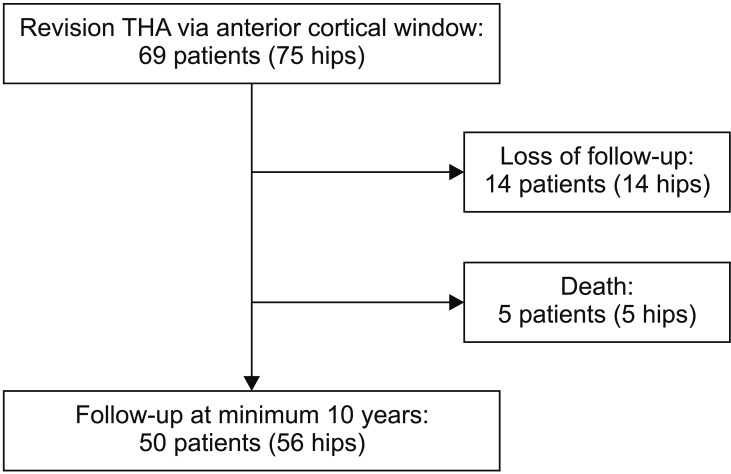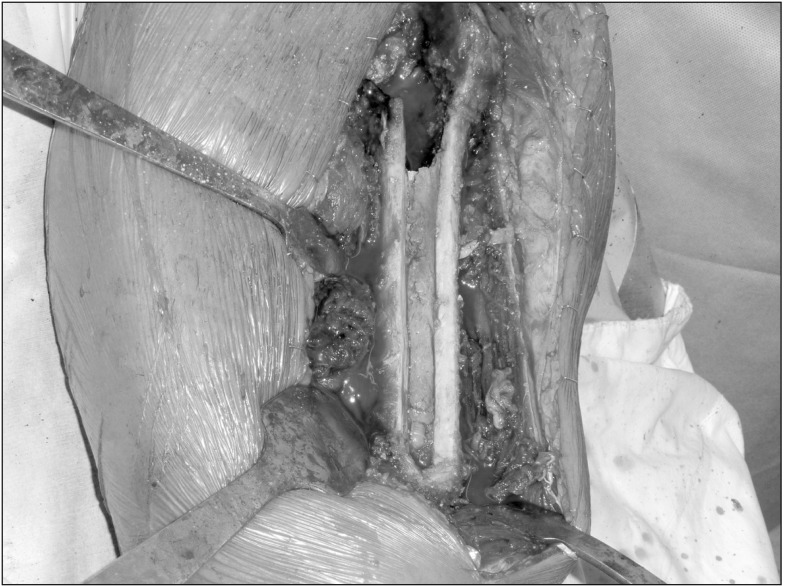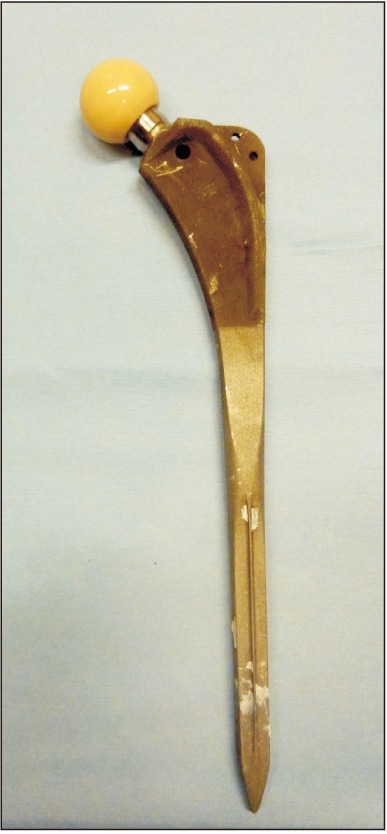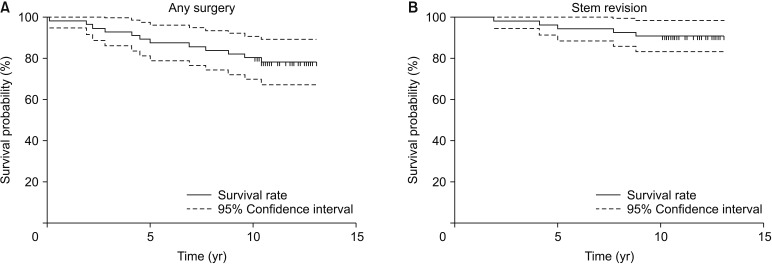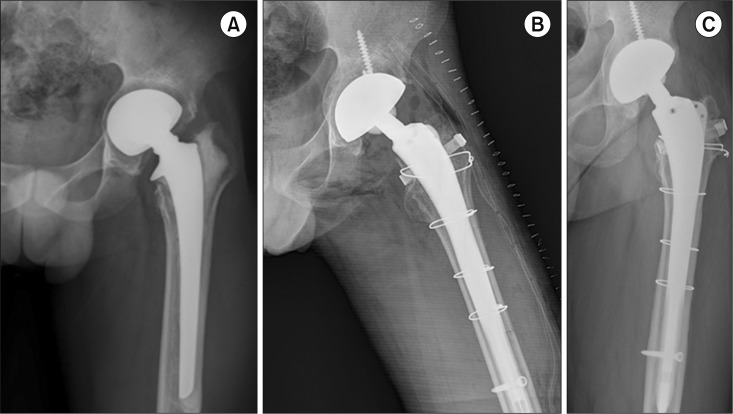Clin Orthop Surg.
2019 Dec;11(4):396-402. 10.4055/cios.2019.11.4.396.
Anterior Cortical Window Technique Instead of Extended Trochanteric Osteotomy in Revision Total Hip Arthroplasty: A Minimum 10-Year Follow-up
- Affiliations
-
- 1Department of Orthopaedic Surgery, Yeungnam University Medical Center, Daegu, Korea.
- 2Department of Orthopedic Surgery, Seoul National University Bundang Hospital, Seongnam, Korea. ykleemd@gmail.com
- 3Department of Orthopedic Surgery, Seoul National University College of Medicine, Seoul, Korea.
- KMID: 2462532
- DOI: http://doi.org/10.4055/cios.2019.11.4.396
Abstract
- BACKGROUND
The anterior cortical window technique was developed to facilitate stem removal in revision total hip arthroplasty (THA). In this technique, only the anterior cortex of the proximal femur is osteomized; the trochanter, lateral cortex, and medial cortex remain intact. Therefore, a new stem can be press-fitted into the femur and mediolateral stability can be obtained. However, the long-term results of revision THA using this technique are unknown. We report the outcome and survivorship at a minimum of 10-year follow-up.
METHODS
From May 2003 to April 2006, 69 patients (75 hips) underwent revision THA using an anterior cortical window and a cementless distal interlocking stem. Of these, 50 patients (56 hips) were followed up for 10 to 13 years (mean, 11.5 years). There were 26 men (29 hips) and 24 women (27 hips) with a mean age of 51.2 years (range, 29 to 82 years) at the time of revision arthroplasty. We evaluated radiographs, Harris hip score, University of California at Los Angeles (UCLA) activity score, Koval category, and survivorship.
RESULTS
Nonunion of the osteotomy occurred in one hip (2%). Five stems (8.9%) subsided 5 mm or more. At the final evaluation, the mean Harris hip score, UCLA activity score, and the Koval category were 82.5, 4.6, and 1.5, respectively. Survivorship with any operations as the end point was 80.4% and that with stem-revision as the end point was 91.1%.
CONCLUSIONS
With use of an anterior cortical window, a well-fixed stem can be easily removed, and a new stem can be inserted with firm mediolateral stability in the proximal femur in revision THA. We recommend using this technique instead of the extended trochanteric osteotomy in revision THA.
Keyword
MeSH Terms
Figure
Reference
-
1. Kurtz S, Mowat F, Ong K, Chan N, Lau E, Halpern M. Prevalence of primary and revision total hip and knee arthroplasty in the United States from 1990 through 2002. J Bone Joint Surg Am. 2005; 87(7):1487–1497. PMID: 15995115.
Article2. Yoon PW, Lee YK, Ahn J, et al. Epidemiology of hip replacements in Korea from 2007 to 2011. J Korean Med Sci. 2014; 29(6):852–858. PMID: 24932089.
Article3. Patel A, Pavlou G, Mujica-Mota RE, Toms AD. The epidemiology of revision total knee and hip arthroplasty in England and Wales: a comparative analysis with projections for the United States. A study using the National Joint Registry dataset. Bone Joint J. 2015; 97(8):1076–1081. PMID: 26224824.4. Younger TI, Bradford MS, Magnus RE, Paprosky WG. Extended proximal femoral osteotomy: a new technique for femoral revision arthroplasty. J Arthroplasty. 1995; 10(3):329–338. PMID: 7673912.5. Chen WM, McAuley JP, Engh CA Jr, Hopper RH Jr, Engh CA. Extended slide trochanteric osteotomy for revision total hip arthroplasty. J Bone Joint Surg Am. 2000; 82(9):1215–1219. PMID: 11005512.
Article6. Mardones R, Gonzalez C, Cabanela ME, Trousdale RT, Berry DJ. Extended femoral osteotomy for revision of hip arthroplasty: results and complications. J Arthroplasty. 2005; 20(1):79–83.7. Huffman GR, Ries MD. Combined vertical and horizontal cable fixation of an extended trochanteric osteotomy site. J Bone Joint Surg Am. 2003; 85(2):273–277. PMID: 12571305.
Article8. Charity J, Tsiridis E, Gusmao D, Bauze A, Timperley J, Gie G. Extended trochanteric osteotomy followed by cemented impaction allografting in revision hip arthroplasty. J Arthroplasty. 2013; 28(1):154–160. PMID: 23084555.
Article9. MacDonald SJ, Cole C, Guerin J, Rorabeck CH, Bourne RB, McCalden RW. Extended trochanteric osteotomy via the direct lateral approach in revision hip arthroplasty. Clin Orthop Relat Res. 2003; (417):210–216. PMID: 14646719.10. Kim YM, Lim ST, Yoo JJ, Kim HJ. Removal of a well-fixed cementless femoral stem using a microsagittal saw. J Arthroplasty. 2003; 18(4):511–512. PMID: 12820097.
Article11. Arif M, Sivananthan S, Choon DS. Revision of total hip arthroplasty using an anterior cortical window, extensive strut allografts, and an impaction graft: follow-up study. J Orthop Surg (Hong Kong). 2004; 12(1):25–30. PMID: 15237118.
Article12. Jack CM, Molloy DO, Esposito C, Walter WL, Zicat B, Walter WK. Limited slot femorotomy for removal of proximally coated cementless stems: a 10-year follow-up of an unreported surgical technique. J Arthroplasty. 2013; 28(6):1000–1004. PMID: 23523213.
Article13. Klein AH, Rubash HE. Femoral windows in revision total hip arthroplasty. Clin Orthop Relat Res. 1993; (291):164–170. PMID: 8504595.
Article14. Moreland JR, Marder R, Anspach WE Jr. The window technique for the removal of broken femoral stems in total hip replacement. Clin Orthop Relat Res. 1986; (212):245–249.
Article15. Yoo JI, Lee TH, Kim JY, Kim JH, Ha YC. Outcomes of hip arthroscopy in a military population are similar to those in the civilian population: matched paired analysis at 2 years. Arthroscopy. 2018; 34(7):2096–2101. PMID: 29685837.16. Compston A. Aids to the investigation of peripheral nerve injuries. Medical Research Council: Nerve Injuries Research Committee. His Majesty's Stationery Office: 1942; pp. 48 (iii) and 74 figures and 7 diagrams; with aids to the examination of the peripheral nervous system. By Michael O'Brien for the Guarantors of Brain. Saunders Elsevier: 2010; pp. [8] 64 and 94 Figures. Brain. 2010; 133(10):2838–2844. PMID: 20928945.
Article17. Meijerink HJ, Gardeniers JW, Buma P, Lemmens JA, Schreurs BW. Hydroxyapatite does not improve the outcome of a bipolar hemiarthroplasty. Clin Orthop Relat Res. 2004; (421):143–150.
Article18. Callaghan JJ, Dysart SH, Savory CG. The uncemented porous-coated anatomic total hip prosthesis: two-year results of a prospective consecutive series. J Bone Joint Surg Am. 1988; 70(3):337–346. PMID: 3346261.
Article19. Capello WN, D'Antonio JA, Geesink RG, Feinberg JR, Naughton M. Late remodeling around a proximally HA-coated tapered titanium femoral component. Clin Orthop Relat Res. 2009; 467(1):155–165. PMID: 18850255.
Article20. Gruen TA, McNeice GM, Amstutz HC. "Modes of failure" of cemented stem-type femoral components: a radiographic analysis of loosening. Clin Orthop Relat Res. 1979; (141):17–27.21. Miner TM, Momberger NG, Chong D, Paprosky WL. The extended trochanteric osteotomy in revision hip arthroplasty: a critical review of 166 cases at mean 3-year, 9-month follow-up. J Arthroplasty. 2001; 16(8 Suppl 1):188–194.
Article22. Kang BJ, Ha YC, Ham DW, Hwang SC, Lee YK, Koo KH. Third-generation alumina-on-alumina total hip arthroplasty: 14 to 16-year follow-up study. J Arthroplasty. 2015; 30(3):411–415. PMID: 25449586.
Article23. Frankel A, Booth RE Jr, Balderston RA, Cohn J, Rothman RH. Complications of trochanteric osteotomy: long-term implications. Clin Orthop Relat Res. 1993; (288):209–213. PMID: 8458136.
Article24. Wieser K, Zingg P, Dora C. Trochanteric osteotomy in primary and revision total hip arthroplasty: risk factors for non-union. Arch Orthop Trauma Surg. 2012; 132(5):711–717. PMID: 22228280.
Article25. Sambandam SN, Duraisamy G, Chandrasekharan J, Mounasamy V. Extended trochanteric osteotomy: current concepts review. Eur J Orthop Surg Traumatol. 2016; 26(3):231–245. PMID: 26923564.
Article26. Schwab JH, Camacho J, Kaufman K, Chen Q, Berry DJ, Trousdale RT. Optimal fixation for the extended trochanteric osteotomy: a pilot study comparing 3 cables vs 2 cables. J Arthroplasty. 2008; 23(4):534–538. PMID: 18514870.27. Zhu Z, Ding H, Shao H, Zhou Y, Wang G. An in-vitro biomechanical study of different fixation techniques for the extended trochanteric osteotomy in revision THA. J Orthop Surg Res. 2013; 8:7. PMID: 23570422.
Article28. Silverton CD, Jacobs JJ, Rosenberg AG, Kull L, Conley A, Galante JO. Complications of a cable grip system. J Arthroplasty. 1996; 11(4):400–404. PMID: 8792246.
Article29. Konan S, Garbuz DS, Masri BA, Duncan CP. Modular tapered titanium stems in revision arthroplasty of the hip: the risk and causes of stem fracture. Bone Joint J. 2016; 98(1 Suppl A):50–53. PMID: 26733641.
- Full Text Links
- Actions
-
Cited
- CITED
-
- Close
- Share
- Similar articles
-
- The Extended Trochanteric Osteotomythrough the Lateral Approachin Revision Hip Arthroplasty
- Revision Total Hip Arthroplasty using Allogenic Impaction Bone Grafts and Cemented Cup in Acetabular Bone Deficiency: Minimum Seven Years Clinical and Radiological Analysis
- Revision Total Hip Replacement using a Cementless Wagner SL Femoral Stem
- Cementless Total Hip Arthroplasty Involving Trochanteric Osteotomy without Subtrochanteric Shortening for High Hip Dislocation
- Surface Replacement Arthroplasty of the Hip

